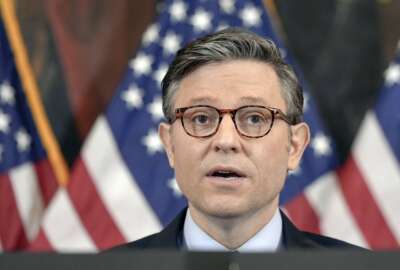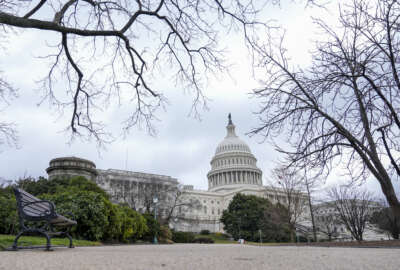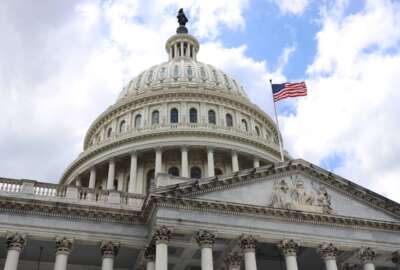‘You’re already wasting money’: Warner says feds pulled away from jobs to handle shutdown prep
Sen. Mark Warner (D-Va.) told reporters the looming threat of a government shutdown has already pulled some federal employees away from their day-to-day jobs.
Congress faces a tight deadline to reach a stopgap spending deal and avoid a government shutdown by the end of the day Friday.
House Republicans reached a new deal Thursday afternoon on a continuing resolution that’s endorsed by President-elect Donald Trump, but failed to pass in a floor vote. Trump said he approved the new deal in a Truth Social post.
The new CR would extend the nation’s debt limit through Jan. 30, 2027. The Treasury Department can currently continue to borrow money until Jan. 1, 2025, but often relies on extraordinary measures to keep paying the federal government’s obligations for months past that deadline.
House Speaker Mike (R-La.) plans to hold another CR vote on Friday, but it remains unclear if any proposal has the votes needed to avert a shutdown.
House lawmakers on Wednesday had reached a bipartisan deal on a CR, which would keep current funding levels in place until March 14, 2025. But Trump rejected that plan and directed congressional Republicans to push for a deal that raised the nation’s debt limit.
Regardless of whether lawmakers reach a deal before midnight Friday, Sen. Mark Warner (D-Va.) told reporters Thursday afternoon that the looming threat of a government shutdown has already pulled some federal employees away from their day-to-day jobs to prepare for a funding lapse.
“People stop doing their normal jobs and start going through a checklist of how you shut this part down and that part down, and who’s going to be deemed essential personnel that can still come in without getting paid, but still come in. So, you are already wasting money,” Warner said.
The Office of Management and Management reached out to agencies about lapse planning last Friday. An OMB official said agencies reached out to employees about the status of funding, starting at 10 a.m. Thursday morning.
“The closer you get to that expiration and the shutdown, those activities increase and the number of people who have to stop their normal job of air traffic control or inspecting, to get ready for a shutdown just increases,” Warner said.
Virginia gets hit by government shutdowns harder than most states, given its high concentration of federal employees and government contractors.
Federal employees receive backpay once a government shutdown ends, but the employees of government contractors don’t have the same guarantee.
“It’s like a kick in the gut,” Warner said. “You’re going to have all of the private-sector government contractors not being paid.”
Warner said a government shutdown would have downstream effects on the American public — especially those traveling during the holiday season.
“Many of you may say, ‘Well, why do I really care about whether the federal government shuts down?’ If you’re going to get on an airplane any time after Friday and go visit a loved one, you’ve got to realize your TSA employees are not getting paid. Your air traffic controllers are not getting paid. Some of them may call in sick. You’re going to have a level of chaos at our airports that I fear could be unprecedented,” Warner said.
TSA Administrator David Pekoske posted on X (formerly Twitter) that 59,000 of the agency’s 62,000 employees are considered essential, and would keep working during a government shutdown.
Pekoske wrote that TSA expects to screen 40 million passengers over the holidays and through Jan. 2, 2025.
“While our personnel are prepared to handle high volumes of travelers and ensure safe travel, please be aware that an extended shutdown could mean longer wait times at airports,” Pekoske wrote.
Data analysis conducted by Federal News Network in September 2023 found that roughly 65% of the overall federal civilian workforce would continue working through a government shutdown, based on government contingency plans available at that time.
Agencies routinely update their contingency plans ahead of a possible shutdown. However, some agencies haven’t updated their contingency plans since 2020 or 2021, making it hard to ascertain exactly how many federal employees would continue to show up for work during a lapse in funding.
Federal News Network’s analysis last year showed that 1.5 million civilian federal employees — out of a total workforce of 2.3 million employees — would continue to work as “exempt” or “excepted” personnel.
“Exempt” employees work in positions that are financed through some funding source other than annual appropriations. They would be unaffected by a lapse in appropriations — at least until those alternative funding sources run out.
“Excepted” employees are paid through annual appropriations, but their agency has determined they must stay on the job even with no funds available to pay them.
Warner also stressed the need for a comprehensive spending deal for the rest of fiscal 2025. He said continuing resolutions continue to “drive up costs” for contractors who can’t start work on next-year contracts.
“There were so many of the ship repair businesses that I met with earlier this week. Because of the CR, they don’t get paid. Their businesses are now in jeopardy. They have to put their house up as collateral to the bank,” Warner said. “You have a shutdown, how many of those businesses are going to just simply say, ‘OK, I’ve got to lay off my workforce, or maybe I’ve got to shut down, because this is just too crazy?'”
Copyright © 2025 Federal News Network. All rights reserved. This website is not intended for users located within the European Economic Area.
Jory Heckman is a reporter at Federal News Network covering U.S. Postal Service, IRS, big data and technology issues.
Follow @jheckmanWFED






